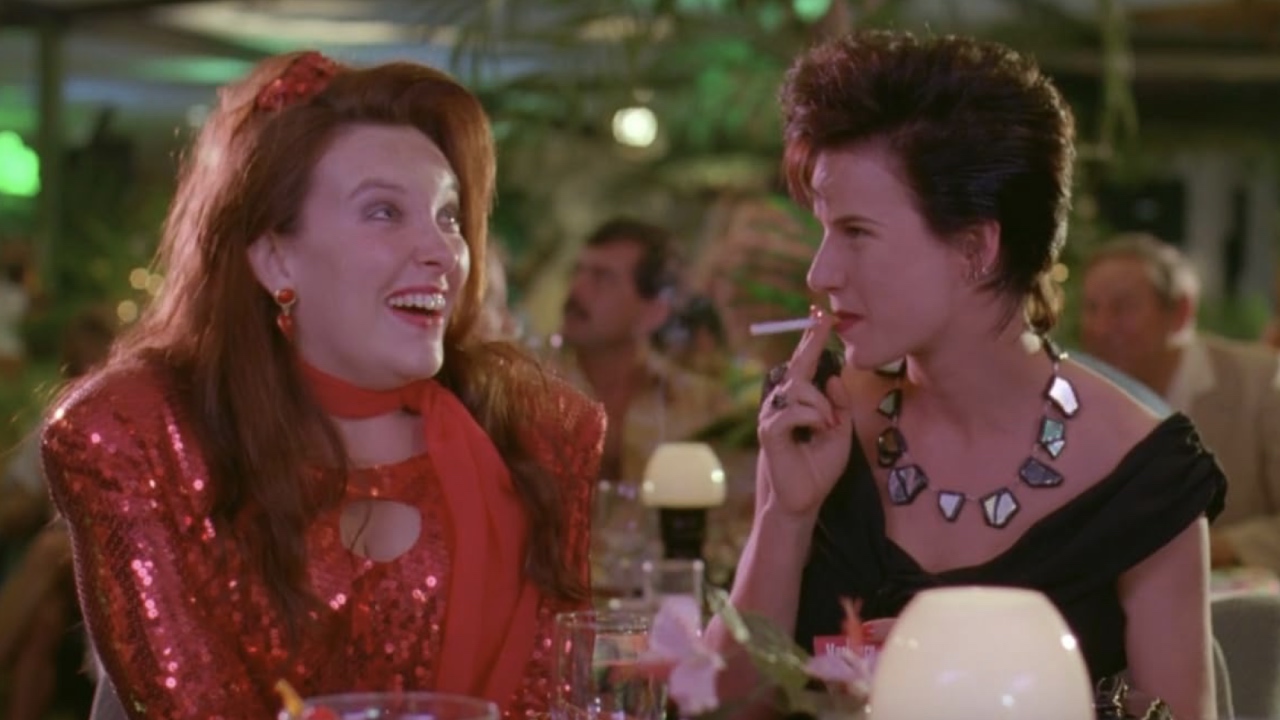‘We’re all Muriel’: why we still love Muriel’s Wedding, 30 years on

P.J. Hogan’s classic Australian film Muriel’s Wedding is 30 and it plays as well today as it did when it had its world premiere. Muriel might have been “terrible” – but the film was a great success.
Australians love to laugh at themselves, and everyone loves an underdog. Muriel’s Wedding took more than A$15 million at the box office in Australia — making it one of the highest-grossing Australian feature films of all time.
As fun as the film is with its kitsch aesthetic, bold colour palette and garish costumes, it has a unique mix of comedy and serious drama. It slips from the absurd to painful realism, with more depth than your average comedy and a twist in the plot that made it an original take on the genre.
While Australians generally have received it as hilarious, audiences elsewhere were more attuned to the tragedy, such as Muriel’s mother Betty’s suicide following relentless bullying, and Rhonda’s illness and disability. But it worked for audiences everywhere who warmed to the representation of friendship, its emotional compassion and critique of the narrow mindedness of small-town communities.
‘We’re all Muriel’
Sometimes it is the stars who can bring in an audience and make a film successful. However, although there were a lot of experienced actors in Muriel’s Wedding, Toni Collette (Muriel) and Rachel Griffiths (Rhonda) – whose performances were exceptional – were both playing lead and supporting roles for the first time in a feature film.
It was also Hogan’s first feature, so it is unlikely star power drew in audiences (although all of them were to become stars, and Hogan later directed My Best Friend’s Wedding with Julia Roberts, one of the top romantic comedies of all time).
It did, however, have a wonderful trailer.
I asked Rachel Griffiths what she thought was the key to the film’s success and she identified its universality: it translated for an array of audiences and enabled broad identification.
She described the film as having one foot in the grotesque and the other in Ridley Scott’s 1991 getaway heist Thelma & Louise – another film about female friendship, independence and individual growth.
Griffiths gave the example of going with the film to New York on its release and discovering it was wildly meaningful to the LGBTQIA+ community. In conversation with a gay man in his late 20s, he described it as a parable for AIDS, which at that time was in full-blown crisis.
According to Griffiths, he said: “We’re all Muriel. We don’t fit in.”
Growing up in small towns where they are “the freak”, with closet musical tastes, he said:
We’re the outcasts in our family. Our fathers belittle us for being feminine. We escape to the big smoke with the promise of becoming ourselves and following our own journey. We replace our families who have rejected us with our chosen family who celebrate us.
And when one of their own is struck suddenly by this terrible affliction, like Rhonda, they are sent home in humiliation, to be looked after, which is their worst fear. The aspiration is to be rescued by the adopted family and taken back to the big city and shown unconditional love.
Griffiths says:
That’s the ending and the survival story of both Rhonda and Muriel, you go back to that kind of pride moment, to be proud of who you are.
For Griffiths, Rhonda and Muriel have “a kind of blood-sister friendship, a bond that can’t be broken”.
We all long for that deep acceptance. It is a parable of inclusion, where Muriel and Rhonda truly see and accept each other and themselves.
A feminist film
I asked Griffiths if Muriel’s Wedding was received as feminist when it was released. She replied it wasn’t at the time it was made, but more recently this has come up.
Her explanation of why this wasn’t considered 30 years ago is informative regarding film criticism. She elaborated that the critics at the time were 90% male and their take on feminism expected powerful female lead characters who pursue their goals and achieve in the face of competition.
In this story, there is a girl escaping patriarchal control. Muriel’s father, Bill Heslop (Bill Hunter), is a bully and narcissist who blames everyone else – especially the women – for his failures.
Griffiths aligns Muriel to the Cinderella myth because in the beginning she sees her value will only be ascribed to her once she marries. The film, Griffiths said, is “a fundamental kind of feminist journey”.
The central focus is Muriel’s personal growth in rejecting ideology that promotes romantic coupling as the pinnacle of happiness for women. Instead Muriel embraces her own worth and her friendship with Rhonda. Marriage is portrayed as a patriarchal structure that ideologically binds women – the marriages are variously fraudulent, starting with Tanya and Chook, then Muriel and, ultimately, her mother.
There are many elements that make Muriel’s Wedding an Australian classic, from the universal themes and relatability to how the story is able to extend beyond national borders. The film leaves us with admiration for resilience in the face of adversity, signalled by Muriel and Rhonda grinning assuredly at each other in the final scene.
It is a unique and very real comedy/drama with a highly engaging aesthetic and a feminist message. It is an opportunity to laugh at ourselves, despite quite a lot of tragedy and adversity — which is a very Australian thing to do!
The author wishes to thank Rachel Griffiths who was interviewed in Melbourne on August 17 2020.
Lisa French, Professor & Dean, School of Media and Communication, RMIT University
Image credits: Miramax
This article is republished from The Conversation under a Creative Commons license. Read the original article.
